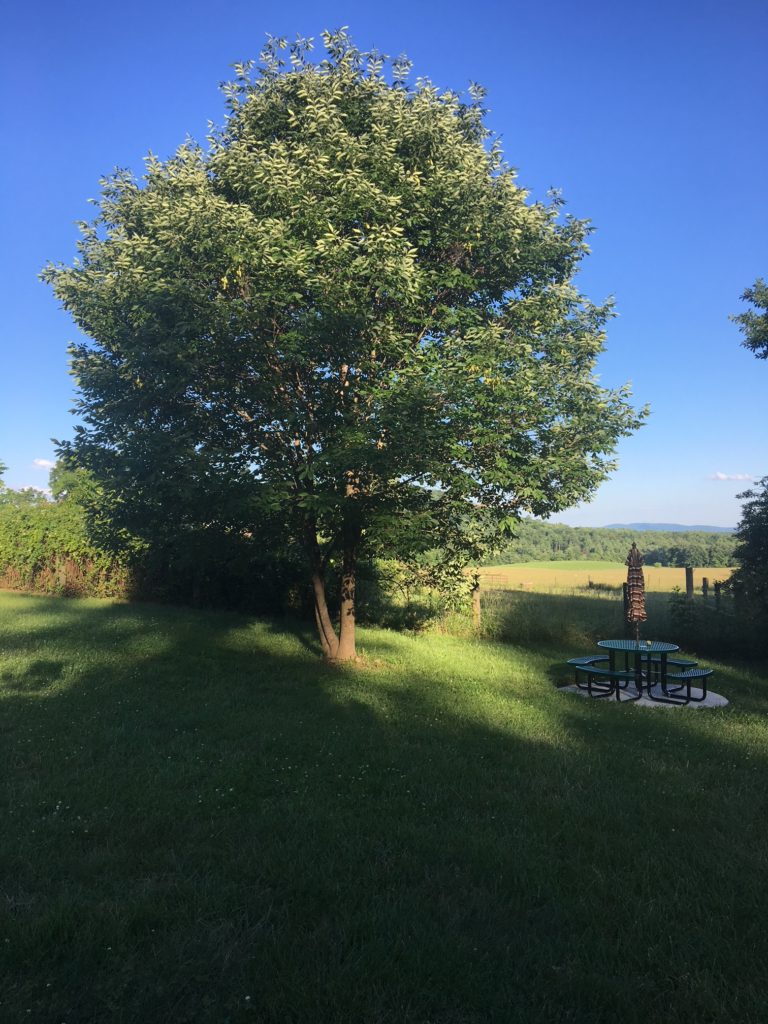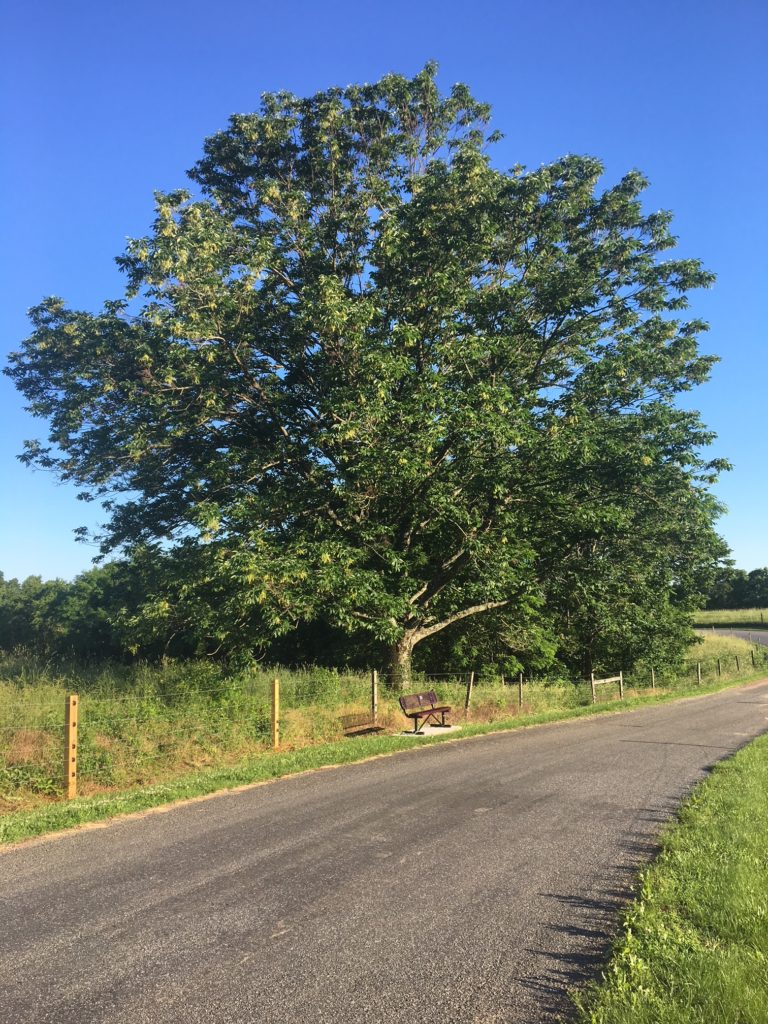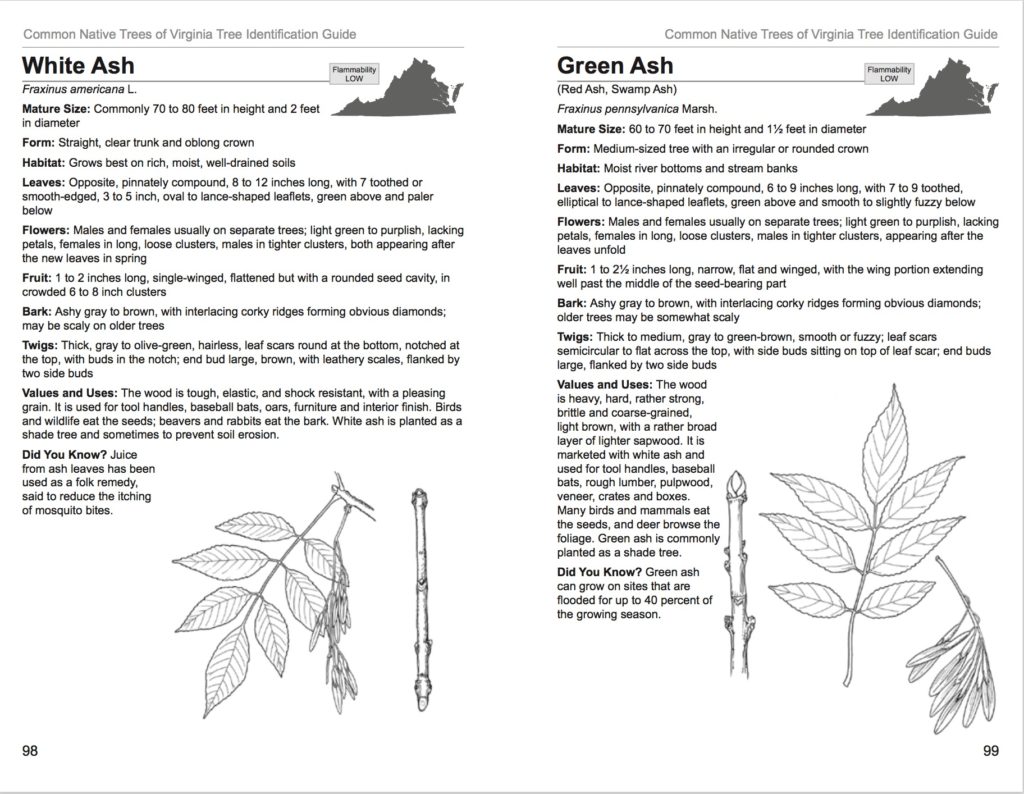

How to Detect Emerald Ash Borers
Trees have to be treated before they are attacked . Here’s how you can tell if emerald ash borers have already attacked.
Symptoms
Crown dieback: Dieback of the upper and outer crown begins after multiple years of EAB larval feeding.
Epicormic Sprouting: When trees are stressed or sick, they will try to grow new branches and leaves wherever they still can. Trees may have new growth at the base of the tree and on the trunk, often just below where the larvae are feeding.
Bark splits: Vertical splits in the bark are caused due to callus tissue that develops around larval galleries. Larval galleries can often be seen beneath bark splits.
Woodpecker feeding: Woodpeckers eat emerald ash borer larvae that are under the bark. This usually happens higher in the tree where the emerald ash borer prefers to attack first. If there are large numbers of larvae under the bark the woodpecker damage can make it look like strips of bark have been pulled off of the tree. This is called “flecking.”
Signs
D-shaped emergence holes: As adults emerge from under the bark they create a D-shaped emergence hole that is about 1/8 inch in diameter. An example of this is shown below.
S-shaped larval galleries: As larvae feed under the bark they wind back and forth, creating galleries that are packed with frass (larva poop) and sawdust and follow a serpentine pattern. An example of this is shown below.
Larvae: As larvae feed under the bark they wind back and forth, creating galleries that are packed with frass (larva poop) and sawdust and follow a serpentine pattern.
Adults: Adult beetles are metallic green and about the size of one grain of cooked rice (3/8 – 1/2 inch long and 1/16 inch wide). Adults are flat on the back and rounded on their underside.
People finding EABs are encouraged to report the sighting. In Virginia call 804-786-3515. An entomologist might be dispatched to confirm the sighting, but it’s up to the property owner to decide the fate of the tree.
by Nancy Sopher with Deborah Lee
The Farmcolony Board of Directors has a tough decision to make over whether or not to save some of the ash trees that grace our farm with their beauty and shade from the encroaching emerald ash borers that are descending on the community. Among the trees being threatened are two large, particularly beautiful ash trees that, one, towers over the newly added memorial bench on Colony Drive and, two, shades the picnic table located in the orchard.
While it may seem like a no-brainer to save key trees, there is a cost to treating the trees against infestation. While estimates are still being collected, our neighbors, the Catalanos, treated four ash trees on their property recently at a cost of $900. Broken down, that amounts to $225 per tree. We expect estimates to go a little higher, but are awaiting a final estimate. Treatment must be repeated every 2-3 years to effectively protect the ash trees from EAB infestation.
The Virginia Department of Forestry has established the Emerald Ash Borer (EAB) Environmental Cost Share Program this year to help fund 50 percent of the cost for treating ash trees against the emerald ash borer. With the grant funding, the cost of treating our most prized ash trees would be approximately one-half of $250, or $125, per tree depending on the final quote. The question is do we want to try to save these valuable trees, or let them go.
This grant program extends through June 15, just 10 days away, so application must be made quickly if we are to take advantage of the program. Homeowners may elect to take advantage of the cost share program as well to save the ash trees on their own property . For more information on the Emerald Ash Borer (EAB) Environmental Cost Share Program and how to apply for grant funding, follow this link to the Department of Forestry website: http://www.dof.virginia.gov/infopubs/_forestry-topics/FT0032_Emerald-Ash-Borer-Cost-Share-Program_2018-03_pub.pdf.
The emerald ash borer is an insect native to eastern Asia first found in the U.S. in Detroit, Michigan, in 2002. This invasive beetle has destroyed more than 100 million ash trees in at least 15 states, including Maryland and Virginia, and threaten billions more across the continent. The insect’s larvae feed on the inner bark of all species of native ash trees.
Unless treated with insecticides, most trees infested by EAB will die within three to five years. Insecticides are available to homeowners and communities to protect valuable landscape ash trees, but the trees have to be treated before they are attacked, and the treatment must be repeated every 2-3 years to remain effective. Some communities are planning re-treatment programs extending 10 years.
The insecticides are typically applied either by injecting the product directly into the base of the trunk or by drenching the soil around the base of a tree. These products have relatively low toxicity to humans and few impacts on non-target organisms, say some experts. The Farmcolony board will be reviewing the toxicity of the insecticide and consider those effects before deciding whether or not to treat the key trees.
One recently approved insecticide provides two to three years of highly effective protection, which should help reduce the treatment costs for homeowners and communities alike. Also, Federal agencies are hopeful that biological control may eventually help control EAB infestations as well. Future costs is another concern for the board.
As stewards, we also have this to consider. As we lose more trees, we also lose biodiversity. A 2009 study in the journal Biological Invasions listed 43 native insect species that rely on ash trees for food or breeding. Those insects are a food supply for birds, including woodpeckers. According to Douglas Tallamy’s book “Bringing Nature Home” (2007), ash trees host 150 species of native moth and butterfly larva. Birds and other wildlife depend on these caterpillars for food. Ash seeds are also a food source for a variety of birds and small mammals.
As ash trees are infected with EAB, they lose more of their leaves and overall canopy resulting in more sunlight getting to the forest floor. More sunlight dries up the forest floor oftentimes leading to the death of other plants and trees located underneath. The drier conditions open the door to various invasive species that have been known to move into these areas. It is hoped that by treating trees, we can slow the spread of EAB and ash mortality, buying some time for research on more options for managing EAB. There are lots of scientists working on the problem while others are working to develop resistant varieties.
The board has to decide. Is it worth spending a minimum of $200-$250 per tree every few years to save our ash trees (or half of that amount this year with funding through the cost share program)? Or is it losing battle? Is the insecticide safe? The cost of treatment has not been budgeted, so where would the money come from?
If we don’t spend the money for treatment, we lose some significant, stately beautiful trees that will leave huge gaps around the farm. But for how long? Something will grow in its place. That’s how nature works. But whatever grows in its place, it will take 10-20-30 years to reach the maturity of the trees we are about to lose.
Rock/hard place.
So what do you think? Should the board spend the money to save key ash trees from the approaching ash borer, or let nature take its course? Should the board opt to save the two most significant ash trees at the above cost? Will you be saving any key ash trees on your property? Either way, the approaching ash borer is likely to change the face of the farm forever. Leave a comment below.
Sources for this article, and for more information:
- https://www.nrs.fs.fed.us/disturbance/invasive_species/eab/effects_impacts/
- https://www.guelphmercury.com/news-story/5030278-guelph-s-losing-battle-with-emerald-ash-borer-was-inevitable-/
- https://www.petoskeynews.com/loss-of-ash-species-could-mean-huge-environmental-impact/article_1138a80e-d25e-5633-bf1d-0f8c3a360ebc.html
- http://www.montpelierbridge.com/2014/05/opinion-the-importance-of-ash-trees-or-what-is-threatening-the-original-vermonter/to
To identify key ash trees on your property, follow the tree guides below from the Virginia Department of Forestry.


“When one tugs at a single thing in nature, he finds it attached to the rest of the world.”
